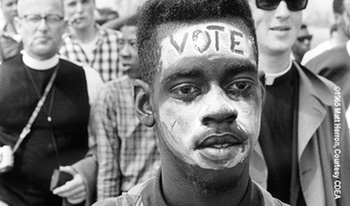
Thu 9/29-5/14/17
More than half a century has passed since the Civil Rights Act changed America.
Over the last few years, the era has been captured and celebrated for all to see in various projects including Hollywood feature film Selma and Broadway hit drama All the Way. The Cleveland Play House is currently producing the latter.
Now comes a new exhibit depicting the troubled journey taken by the Southern Freedom Movement that led to the Civil Rights Act. Chronicling the history of division is This Light of Ours: Activist Photographers of the Civil Rights Movement, which features more than 150 black-and-white images from the era.
The 4,000-square-foot exhibition appears 9/29-5/14 at the Maltz Museum of Jewish Heritage. This Light of Ours: Activist Photographers of the Civil Rights Movement includes works by nine activist photographers, as well as videos, interactive features and content about modern-day struggles.
CoolCleveland talked to Maltz Museum of Jewish Heritage education director Jeffery Allen about the compelling exhibit.
What was it about This Light of Ours: Activist Photographers of the Civil Rights Movement that had the Maltz Museum interested?
It was telling the story of the Freedom Summer, the effort by student activists to organize voting rights for African Americans largely disenfranchised in the south. Cleveland, of course, had its own troubled history. In 1963 and 1964, there were segregated schools where Africa-American students were only going to school for half a day while white schools on the other end of the town were left largely empty and with half-full classrooms. These issues coming to the forefront in our own troubled history reminds us today as we’re approaching an election year that we still have a lot of work to do in terms of race relations, trust in the institution, trust in the voting system and in terms of voting rights. It’s an extraordinary opportunity to tell the story of our past and look where we are today and where we’re going tomorrow. And it’s a great opportunity for the museum, which stands for diversity and tolerance. We focus on upstanders. Young people were at the core of this movement, and they took a stand.
Is this a touring exhibit or did the Maltz Museum create any of the content?
It’s a touring exhibition but the Maltz Museum has added two films, 3D structures and an entire section dedicated to Northeast Ohio. An opening film takes us back to the Middle Passage. It sets the stage for our troubled history of race relations in this country from our earliest day. The closing film wraps up where we are today and challenges the audience that we need to talk. We have unfinished business. And what are we going to do about it?
What did you learn about this important period of time in American history?
I think it’s really important to recognize from this era that it was a largely youth-led movement of non-violent protests. And it was a coming together of both white and black to get voting rights of people who were living in the South at this time. We have one story about a county with 60,000 people. Half of that population was Africa-American but only 200 were registered to vote. That’s a staggering number.
How does the exhibit fit into what’s happening in the country today?
The images you’ll see were taken by photographers who were actually activist members of the movement itself. So you’re seeing on-the-ground raw footage from this movement and these images of protest, images/vigils of defiance and even images of violence are extraordinarily relevant. You can take one of these pictures today and compare it to images we’re seeing today and you’d see very little difference. Perhaps the only difference between the photographs we’re featuring are largely black and white and perhaps you’d get color photographs of content today. But the imagery and type of events that are happening today are eerily similar.
So is today’s movement any different from what was happening 50 years ago?
I’d love to leave that question to the audience to discover on their own because I think you’ll see similarities and you’ll see differences. Certainly a similarity is young people were involved. Certainly a big difference would be the way we get information out now is so much faster. Things go viral in a few minutes and you learn about these incidences instantly versus having to rely on the front page of the newspaper and the evening news on television.
Considering its subject matter, do you expect visitors taking in This Light of Ours: Activist Photographers of the Civil Rights Movement will leave feeling depressed?
I don’t think so at all. The opening image and the closing image are the same, which is that of a group of people marching. I think if anything, you’re left with a ray of hope that through effort, coming together for just cause, that we can in fact make change. The story, although you’ll see iconic people like Martin Luther King Jr., really involved every-day people who took part in this movement. Everyday upstanders made positive change in the world.

Beachwood, OH 44122